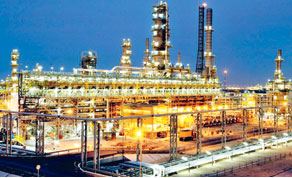 Business & Finance Club Magazine - Oil & Gas Sector - Qatar: Qatar’s plans to double the size of its condensate refinery in Ras Laffan will not only boost its capacity to pump diesel and other middle distillates but will also give it an economic edge over other regional refineries.
It is cheaper to convert condensates to high value fuel such as diesel and jet fuel than it is to process much of the region’s crude that is used by competing refineries.
The world’s largest liquefied natural gas (LNG) exporter is set to boost its condensate production to 750,000 bpd by 2014, more than double current output of around 350,000 bpd and almost as much as the Opec member’s daily crude output.
Output of this light and low sulphur crude equivalent has risen rapidly in Qatar as the country boosts LNG export to 77mn tonnes per annum this year, and comes cheap to the refinery as a by-product of gas output.
“Qatar is going to be able to offer a better price, and deal for its customers just because this condensate is coming to them at next to nothing,” said Al Troner, president of Asia Pacific Energy Consulting in Houston.
This would give it an advantage over other refineries under construction or in the planning stages in the region with heavier crude feedstock.
“At the end of the day it’s a numbers game, if you can refine high end products on the cheap and sell them much higher, you win... that is the case with the Qatar,” an Asian-based energy analyst said.
The inter-Gulf oil products market is growing fast as demand rises rapidly in the region. Gulf countries are also set to compete for export markets in Europe and Asia as they build refinery capacity as part of efforts to industrialise and to take a bigger slice of profits further down the oil supply chain.
Not only would production of quality fuel rise with the Ras Laffan expansion, but condensate will give it more flexibility than crude refineries to meet shifting demand patterns through changes in refinery configuration.
“If co-ordinated and if blending reaches some level of sophistication, this will give Qatar great flexibility in both pitching quality products and shifting the maximization of any specific product,” said Troner.
The 146,000 bpd condensate refinery at Ras Laffan produces 24,000 bpd of gas oil, 52,000 bpd of kerosene and jet fuel and 8,000 bpd of liquefied petroleum gas (LPG). Most of this fuel is aimed at markets in Southeast Asia and Europe.
Qatar plans to double the size of the plant, making it a mid-size refinery for the region.
“They are going to give Saudi and Kuwait a good run for their money especially for middle distillates, Qatar is going to be a new kind of supplier,” Troner said.
The world’s top oil exporter, Saudi Arabia, is expected to add around 800,000 bpd of new refining capacity by 2015 but its heavy investment and use of crude as a feedstock would give Qatar a comfortable edge, Troner said.
Output of condensate in the region is rising quickly as producers boost gas capacity to meet the increasing needs of power plants.
Condensate production in the Middle East is expected to rise to between 3mn bpd and 3.5mn bpd by 2020 from around 1.5mn bpd-2mn bpd currently, according to data from FACTS Global Energy.
Qatar is responsible for about 27% of the condensate production from the region. Saudi Arabia, the world’s top oil exporter, has a 19% share.
The Organisation of the Petroleum Exporting Countries has no limits on the production of this light oil.
Qatar would also boost supplies of middle distillates through its gas-to-liquids project with Royal Dutch Shell, a $19bn plant that Shell describes as the world’s largest energy project.
Fuel from this plant is super-clean and can be blended into other fuels to improve its quality.
Qatar is looking to lock in future export markets for the condensate that it cannot refine.
Qatar Petroleum has bought a stake in Royal Dutch Shell petrochemical joint ventures in Singapore. Under the deal, Qatar will supply the plants with cheap condensate and liquefied petroleum gas (LPG). Qatar’s LPG output was also rising rapidly as it boosts gas production capacity, and was set to reach 13mn tonnes per year in 2014.
“They will sell below market prices, undercutting their competition, just to lock in their volumes,” Troner said.
Qatar, Shell and Petrochina are also looking at the viability of building a refining and petrochemical complex in China.
|